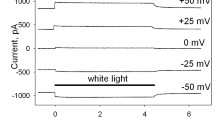Abstract
We recently presented evidence showing that the visible CD spectrum of the purple membrane from Halobacterium halobium consists of two contributions: a broad positive band centered at the absorption maximum due to the interaction of the chromophore with the protein to which it is bound, and an exciton coupling band due to the interaction between chromophores of adjacent bacteriorhodopsin molecules in the hexagonal surface lattice (Heyn et al., 1975). This interpretation receives strong support from the present experiments in which the chromophore-free membrane is reconstituted by the addition of retinal. Since the coupling signal arises from the interaction between pairs of neighboring chromophores, its contribution to the spectrum would be expected to be very small in the initial stages of the titration experiment, but increasing quadratically with the percentage reconstitution. The broad positive band, on the other hand, is expected to increase linearly with the percentage reconstitution. On the basis of these considerations a satisfactory explanation of the CD reconstitution experiments could be given. Since it appears to be impossible to explain the titration experiments without the quadratic term, we conclude that chromophore-chromophore interactions play an important role. No significant changes in secondary structure upon reconstitution could be detected consistent with our binding model which neglects cooperativity.
Similar content being viewed by others
Abbreviations
- CD:
-
circular dichroism
- UV:
-
ultraviolet
References
Blaurock, E. A.: Bacteriorhodopsin: a trans-membrane pump containing α-helix. J. molec. Biol. 93, 139–158 (1975)
Blaurock, E. A., Stoeckenius, W.: Structure of the purple membrane. Nature New Biol. 233, 152–154 (1971)
Henderson, R.: The structure of the purple membrane from Halobacterium halobium: analysis of the X-ray diffraction pattern. J. molec. Biol. 93, 123–138 (1975)
Henderson, R., Unwin, P. N. T.: Three-dimensional model of purple membrane obtained by electron microscopy. Nature (Lond.) 257, 28–32 (1975)
Heyn, M. P.: Dependence of exciton circular dichroism amplitudes on oscillator strength. J. Phys. Chem. 79, 2424–2426 (1975)
Heyn, M. P., Bauer, P.-J., Dencher, N. A.: A natural CD label to probe the structure of the purple membrane from Halobacterium halobium by means of exciton coupling effects. Biochem. Biophys. Res. Commun. 67, 897–903 (1975)
Honig, B., Ebrey, T. G.: The structure and spectra of the chromophore of the visual pigments. Ann. Rev. Biophys. Bioeng. 3, 151–177 (1974)
Johnson, W. C., Jr., Tinoco, I., Jr.: Circular dichroism of polynucleotides: a general method applied to dimers. Biopolymers 8, 715–731 (1969)
Oesterhelt, D.: The purple membrane of Halobacterium halobium: a new system for light energy conversion. In: Energy transformation in biological systems, pp. 147–167. ASP 1975
Oesterhelt, D., Hess, B.: Reversible photolysis of the purple complex in the purple membrane of Halobacterium halobium. Europ. J. Biochem. 37, 316–326 (1973)
Oesterhelt, D., Meentzen, M., Schuhmann, L.: Reversible dissociation of the purple complex in bacteriorhodopsin and identification of 13-cis and all-trans-retinal as its chromophores. Europ. J. Biochem. 40, 453–463 (1973)
Oesterhelt, D., Schuhmann, L.: Reconstitution of bacteriorhodopsin. FEBS Letters 44, 262–265 (1974)
Oesterhelt, D., Schuhmann, L., Gruber, H.: Light-dependent reaction of bacteriorhodopsin with hydroxylamine in cell suspensions of Halobacterium halobium: demonstration of an apo-membrane. FEBS Letters 44, 257–261 (1974)
Oesterhelt, D., Stoeckenius, W.: Rhodopsin-Iike protein from the purple membrane of Halobacterium halobium. Nature New Biol. 233, 149–152 (1971)
Razi Naqvi, K., Gonzalez-Rodriguez, J., Cherry, R. J., Chapman, D.: Spectroscopic technique for studying protein rotation in membranes. Nature New Biol. 245, 249–251 (1973)
Schellman, J. A.: Symmetry rules for optical rotation. Accounts Chem. Res. 1, 144–151 (1968)
Tinoco, I., Jr.: The exciton contribution to the optical rotation of polymers. Radiat. Res. 20, 33–139 (1963)
Author information
Authors and Affiliations
Rights and permissions
About this article
Cite this article
Bauer, P.J., Dencher, N.A. & Heyn, M.P. Evidence for chromophore-chromophore interactions in the Purple Membrane from reconstitution experiments of the chromophore-free membrane. Biophys. Struct. Mechanism 2, 79–92 (1976). https://doi.org/10.1007/BF00535654
Received:
Issue Date:
DOI: https://doi.org/10.1007/BF00535654




